Related Research Articles
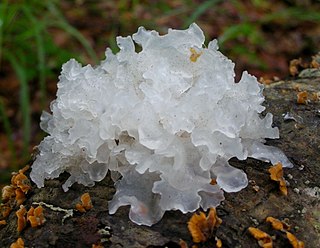
Tremella fuciformis is a species of fungus; it produces white, frond-like, gelatinous basidiocarps. It is widespread, especially in the tropics, where it can be found on the dead branches of broadleaf trees. This fungus is commercially cultivated and is one of the most popular fungi in the cuisine and medicine of China. Tremella fuciformis is commonly known as snow fungus, snow ear, silver ear fungus, white jelly mushroom, and white cloud ears.
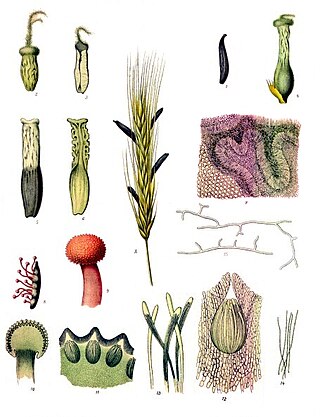
The Clavicipitaceae are a family of fungi within the order Hypocreales. A 2008 estimate placed 43 genera in the family, but a study in 2020 has increased this number to 50.
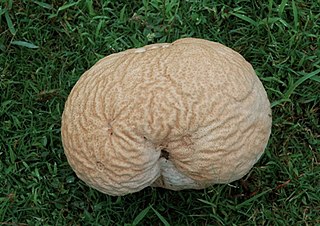
Calvatia craniiformis, commonly known as the brain puffball or the skull-shaped puffball, is a species of puffball fungus in the family Agaricaceae. It is found in Asia, Australia, and North America, where it grows on the ground in open woods. Its name, derived from the same Latin root as cranium, alludes to its resemblance to an animal's brain. The skull-shaped fruit body is 8–20 cm (3–8 in) broad by 6–20 cm (2–8 in) tall and white to tan. Initially smooth, the skin (peridium) develops wrinkles and folds as it matures, cracking and flaking with age. The peridium eventually sloughs away, exposing a powdery yellow-brown to greenish-yellow spore mass. The puffball is edible when the gleba is still white and firm, before it matures to become yellow-brown and powdery. Mature specimens have been used in the traditional or folk medicines of China, Japan, and the Ojibwe as a hemostatic or wound dressing agent. Several bioactive compounds have been isolated and identified from the brain puffball.

Members of the Monoblepharidomycetes have a filamentous thallus that is either extensive or simple and unbranched. They frequently have a holdfast at the base. In contrast to other taxa in their phylum, some reproduce using autospores, although many do so through zoospores. Oogamous sexual reproduction may also occur.

Metarhizium is a genus of entomopathogenic fungi in the Clavicipitaceae family. With the advent of genetic profiling, placing these fungi in proper taxa has now become possible. Most turn out to be the asexual forms (anamorphs) of fungi in the phylum Ascomycota, including Metacordyceps spp.

Calostoma is a genus of 29 species of gasteroid fungi in the suborder Sclerodermatineae. Like other gasteroid fungi, Calostoma do not have the spore discharge mechanism associated with typical gilled fungi (ballistospory), and instead have enclosed spore-bearing structures. Resembling round puffballs with raised, brightly-colored spore openings (osteoles), elevated on a thick, gelatinous stalks, species have been collected in regions of deciduous, temperate, tropical or subtropical forests. Their distribution includes eastern North America, Central America, Asia, and Australasia. The common name given to some species, "prettymouth", alludes to the brightly-colored raised openings (osteoles) that may somewhat resemble lips. Other common names include "hotlips" and "puffball in aspic".
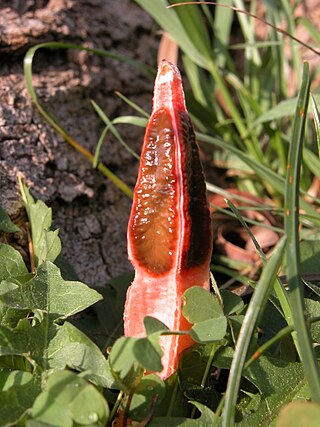
Lysurus mokusin, commonly known as the lantern stinkhorn, the small lizard's claw, or the ribbed lizard claw, is a saprobic species of fungus in the family Phallaceae. The fruit body consists of a reddish, cylindrical fluted stipe that is capped with several "arms". The arms can approach or even close in on each other to form a spire. The gleba—an olive-green slimy spore mass—is carried on the outer surface of the arms. The fruit body, which has an odor comparable to "fresh dog feces", "rotting flesh", or "sewage" when mature, is edible in its immature "egg" stage. The fungus is native to Asia, and is also found in Australia, Europe and North America, where it is probably an introduced species. It has been used medicinally in China as an ulcer remedy.
Kobayasia is a genus of fungi in the family Phallaceae. It contains the species Kobayasia nipponica(Kobayasi) S.Imai & A.Kawam. and Kobayasia kunmingica M.Zang, K.Tao & X.X.Liu.

Polyozellus is a fungal genus in the family Thelephoraceae, a grouping of mushrooms known collectively as the leathery earthfans. Previously considered a monotypic genus, it now contains the Polyozellus multiplex species complex. The genus name is derived from the Greek poly meaning many, and oz, meaning branch. It is commonly known as the blue chanterelle, the clustered blue chanterelle, or, in Alaska, the black chanterelle. The distinctive fruit body of this species comprises blue- to purple-colored clusters of vase- or spoon-shaped caps with veiny wrinkles on the undersurface that run down the length of the stem.
Shimizuomyces is a genus of fungi within the Clavicipitaceae family.
Pseudoauricularia is a genus of fungi in the family Agaricaceae. This is a monotypic genus, containing the single species Pseudoauricularia papuana, described as new to science in 1982 by Japanese mycologist Yosio Kobayasi.
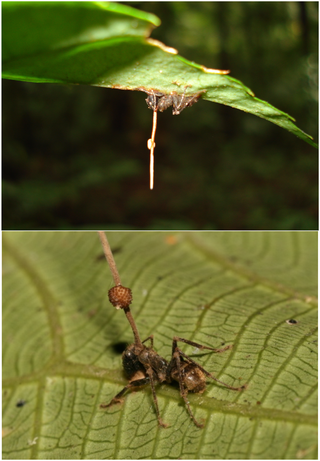
Ophiocordycipitaceae is a family of parasitic fungi in the Ascomycota, class Sordariomycetes. It was updated in 2020.
Holtermannia is a genus of fungi in the order Holtermanniales. Species produce groups of horn-like gelatinous basidiocarps on wood and have associated yeast states. The genus is distributed in southeast Asia and Brazil, and contains six species.
Heliogaster is a sequestrate genus of fungi in the family Boletaceae. This is a monotypic genus, containing the single species Heliogaster columellifer, found in Japan. The genus was first described in 2010, to accommodate the species formerly named Octaviania columellifera by Kobayasi in 1937.

Purpureocillium is a fungal genus in the Ophiocordycipitaceae family. The genus now contains at least 5 species with the type species Purpureocillium lilacinum, a common saprobic, filamentous fungus. It has been isolated from a wide range of habitats, including cultivated and uncultivated soils, forests, grassland, deserts, estuarine sediments and sewage sludge, and insects. It has also been found in nematode eggs, and occasionally from females of root-knot and cyst nematodes. In addition, it has frequently been detected in the rhizosphere of many crops. The species can grow at a wide range of temperatures – from 8 to 38 °C for a few isolates, with optimal growth in the range 26 to 30 °C. It also has a wide pH tolerance and can grow on a variety of substrates. P. lilacinum has shown promising results for use as a biocontrol agent to control the growth of destructive root-knot nematodes.
Poromycena hanedai is a species of agaric fungus in the family Mycenaceae. Found in Japan, the species was first described by Kobayasi in 1951. It is bioluminescent.

Ophiocordyceps formicarum is an entomopathogenic fungus belonging to the order Hypocreales (Ascomycota) in the family Ophiocordycipitaceae. The fungus was first described by mycologist George S. Kobayashi in 1939 as a species of Cordyceps. Originally found in Japan growing on an adult Hercules ant, it was reported from Guizhou, China, in 2003. It was transferred to the new genus Ophiocordyceps in 2007 when the family Cordycipitaceae was reorganized. A technique has been developed to grow the fungus in an agar growth medium supplemented with yeast extract, inosine, and glucose.

Isaria is a genus of fungi mostly in the order Hypocreales and family Clavicipitaceae, or by some authorities the Cordycipitaceae. It includes a large number of entomopathogenic species, some of them exploited as biopesticides : often previously assigned to the genus Paecilomyces.
Oidiodendron is a genus of fungi in the family Myxotrichaceae. It has 26 species. The genus was circumscribed by Norwegian forester Håkon Robak in 1932, with Oidiodendron fuscum assigned as the type species. The species is now known as Oidiodendron tenuissimum.
References
- ↑ Kirk PM, Cannon PF, Minter DW, Stalpers JA (2008). Dictionary of the Fungi (10th ed.). Wallingford, UK: CABI. p. 98. ISBN 978-0-85199-826-8.
- ↑ Kobayasi Y. (1937). "Fungi Austro-Japoniae et Micronesiae I" (PDF). Botanical Magazine Tokyo. 51 (609): 749–58. doi:10.15281/jplantres1887.51.749.[ permanent dead link ]